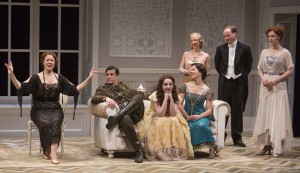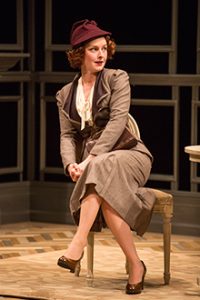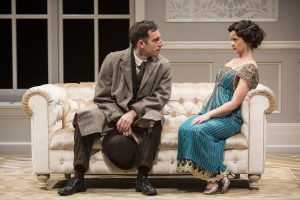Period Family Savagery in Old Globe’s Time and the Conways
“A seed, easily destroyed,” somebody says in J. B. Priestley’s play Time and the Conways, “might have grown into an oak.”
Few Conway seeds escape mutilation in this savage drama disguised with the polish of fashionable British theatre between the world wars. And Priestley, using flash-forward as a device to extract bitter ironies, spreads indictments throughout all elements of his country’s middle-class mentality.
The first act, in 1919, is a merry birthday party with charades, featuring the four blooming daughters and two fine sons of the widow Conway, giddy with excitement at the rosy future. Act Two, in the same room, is a poisonous family meeting 18 years later to decide the next step through financial and spiritual ruin. Act Three swoops back to the golden post-party glow, revealing the roots of ruin in the early assaults on those seeds.

In the Old Globe Time and the Conways are, left to right, Kim Martin-Cotten, Lee Aaron Rosen, Leanne Agmon, Rose Hemingway, Sarah Manton, Jonathan Fielding,and Amanda Quaid. Jim Cox Photo.
Tennessee Williams may have learned much from this castrating mother. Under the banner of protection, she smothers; her rigid rankings allow no appeal. Williams reduced the cast and milked the subtleties more precisely but Priestley’s creation is just as brutal and even more clueless. Her smug cruelty is breath-catching, the monstrous consequences all too sadly foretold.
The unusual poignancy of the play comes from the author’s diabolical dash of déjà vu for Kay, the birthday girl: In 1937, a self-loathing pop journalist and adulteress but also the most successful of the lot, she watches with impotent horror as the remnants of the family rips itself apart, then finds upon return to 1919 that she retains the memory of all those nasty fates.
Priestley was known to be fascinated with tricks of memory and dreams but it’s an exaggeration to cite time as the subject of this play, title notwithstanding. Instead, Kay’s sudden view into the bleak future basically is a theatrical device to heighten the impact on the audience and also, quite possibly in those dour days of 1937, to scold the British audiences for the country’s postwar loss of momentum.
The Old Globe Theatre production of Time and the Conways is a measure of the company’s stature as a mature and responsible custodian of theatre both classic and modern. Priestley (1894-1984, best known work: An Inspector Calls) was a major voice of a recent period. Though he wrote 43 plays, 32 novels and 61 works of non-fiction, and flourished as a radio sage during the early days of World War II, he is neglected and threatened with oblivion. With this production, the Globe not only demonstrates that theatrical history deserves attention but also that unfamiliar work can be revived with rewarding results.
Rebecca Taichman’s staging is deft and appropriate, with the play’s elements sorted out clearly and the telling tics found and emphasized. The décor is somber: Neil Patel’s austere, minimal scenery; David Israel Reynoso’s accurate and eloquent costumes of both periods; the stern lighting of Scott Zielinski. Nowhere is the intelligent balance of this production more evident than at the final curtain, when the victim of the haunted vision freezes downstage in horror as the oblivious others float away upstage.
Amanda Quaid plays the visionary Kay with a flutter of desperate ambition in youth and a tired veneer of cynical resignation as an adult. Morgan Hallett is the feisty socialist sister, Rose Hemingway is the sister on the make for the good life and Leanne Agmon plays everybody’s favorite, the big-hearted baby of the family who, alone among the siblings, seems capable of surviving anything.
Lee Aaron Rosen is the tall, handsome, widely-admired son and Jonathan Fielding plays, with a stutter, the nebbish background son. The lot of them are neatly cast and smoothly grooved as an ensemble.
As the family lawyer, Leo Marks fades memorably from young lion to old tabby and Sarah Manton is all blonde giggles as a pretty baggage hoping to be invited into the family.
Crude, dark and sinister are the choices of Max Gordon Moore, playing the upstart imposter from the lower classes. Moore’s ready intensity makes his courtship of a squeamish daughter echo Richard III’s conquest of a victim’s widow. His churlish ferocity in the middle act seems over the top until we revisit Mom.
In a role that sets a speed record for ruining lives, Kim Martin-Cotten plays Mrs. Conway as a regal despot with an intimidating smile that shows more teeth the longer you watch. Her specialty is the flick of dismissal followed by the false warmth of self-satisfaction. For the finale, the actress fairly bathes in the glow of the fuses set all around her, full justification for the carnage to come.
[box] Continues at 7 p.m. Tuesdays, Wednesdays and Sundays; 8 p.m. Thursdays-Saturdays; and 2 p.m. Saturdays and Sundays through May 4.[/box]

Welton Jones has been following entertainment and the arts around for years, writing about them. Thirty-five of those years were spent at the UNION-TRIBUNE, the last decade was with SANDIEGO.COM.




